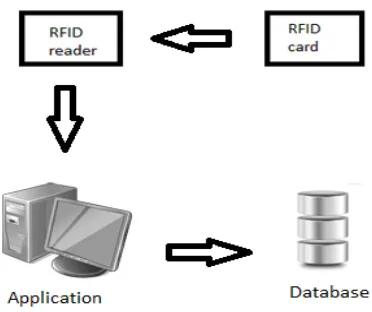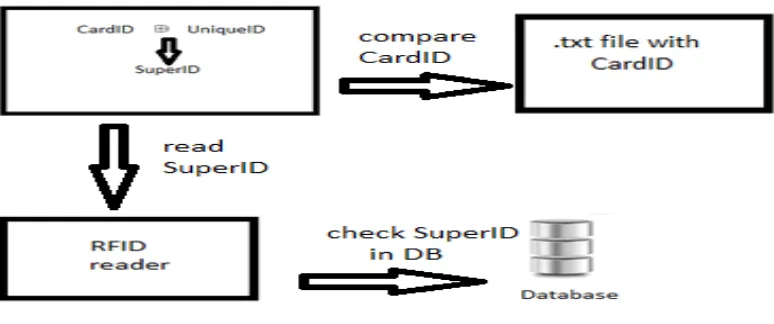An Implementation of MD5 Hash Algorithm for RFID
Tags
Nurbek Saparkhojayev
MSc in CSCE, PhD candidate, Senior Lecturer, Suleyman Demirel University, Almaty, Kazakhstan
Kaskelen, Almaty, Kazakhstan
Olzhas Shaiken
Bachelor student,Suleyman Demirel University, Almaty, Kazakhstan Kaskelen, Almaty, Kazakhstan
shaiken.olzhas@gmail.com
ABSTRACT
This paper discusses RFID technology, and shows the implementation of MD5 hash algorithm for RFID tags to protect private data from counterfeiting and copying. Privacy and security of RFID tags are discussed and the
implementation of this algorithm is shown. Authors present new technology of reading the data from RFID- cards by using MD5 hash function. The reason of applying this algorithm is trivial: it is fast comparing to other algorithms, and can handle small-fixed size of data, which is stored in low-cost RFID-cards, which means that it has 1 Kb of memory. This work was done as a part of project called “Smart Campus” in Suleyman Demirel University, Almaty, Kazakhstan.
General Terms
RFID Privacy and Security, Algorithms.
Keywords
RFID technology, counterfeiting, MD5 algorithm, privacy, security.
1.
INTRODUCTION
Radio-frequency identification (RFID) is a technology that uses radio waves to transfer data from an electronic tag – called an RFID tag or label, which is attached to an object – through a reader for the purpose of identifying and tracking the object. It is possible for some RFID tags to read from several meters away and beyond the line of sight of the reader. Nowadays, RFID systems have been widely used in many different application areas of industry, such as: product
[image:1.595.328.514.255.411.2]attendance management system based on iris recognition. In [1], the beta-version of “Smart Campus” project was presented. They presented first module, which aimed to automatically check students’ attendance. However, they built their system without using an MD5 algorithm; the most important concern was to start this project. In this research paper introduced the implementation of MD5 for this project. Also, there was some other research work done [5] in Europe, in which authors proposed attendance management system by the use of computer vision algorithms. They used real-time face detection algorithms integrated on an existing Learning Management System (LMS), which automatically checks, detects and registers student attending on a lecture. This is a quite interesting approach since this software works with almost no-human interaction. MD5 is well-known and most widely used cryptographic hash function at current time. MD5 is the hash function designed by Ron Rivest as a strengthened version of MD4 [6]. It has been the most widely used secure hash algorithm, particularly in Internet-standard message authentication. MD5 has also been proposed as the default authentication option in IPv6 [7]. In this research, authors relied on a MIFARE RFID-tag, specifically, the MIFARE MF1ICS50 typed RFID-tag. This type of tag was developed by NXP to be used in a contactless smart card according to ISO/IEC 14443 Type A. The MIFARE MF1ICS50 IC is used in such applications as public transportation ticketing, which major cities of the world have adopted as their e-ticketing solution. The MF1ICS50 chip consists of a 1 K-byte EEPROM, a RF-Interface and a Digital Control Unit. Energy and data are transferred via an antenna comprising a coil with a few turns directly connected to the MF1ICS50 [8].
As RFID-reader, Stronglink’s SL040A was used due to its cheapness and ease of use. This reader enables the contact-free reading and writing of operations and works on a 13.56 MHz frequency. It can read the unique serial number of all MIFARE cards, including MIFARE Classic 1K, MIFARE Classic 4K, MIFARE Mini, Ultralight, DESFire, MIFARE Plus, MIFARE ProX, etc.[9].
[image:2.595.321.477.71.232.2]
Fig 3: RFID reader SL040A
2.
IMPLEMENTATION
Program reads from RFID card and checks for authenticity. Each RFID card has 4 blocks and 16 sectors, in which data is stored. Size of each sector is 32 digits long, because of this, all data will be 32 length. RFID cards have their own 32 digits long CardID stored in zero block, zero sector. Beside this CardID, another ID was created, which is called UniqueID, and it is 32 digits long. These two different ID’s are stored in .txt file. Then, after combining these both IDs by XOR operation for each RFID card, the new ID so-called SuperID is created, and the size of this SuperID is the same as previous ones- 32 digits long.
CardID UniqueID = EMD5(SuperID)
Fig 4: The workflow of algorithm, implemented in this research
The overall structure of this workflow:
1. Student comes to the reader and processes his/her own card.
2. Reader reads SuperID and checks in database this value with stored one. If there is no such SuperID, program prompts “Attempt of copy or not registered card” and exits.
3. After successfully passing SuperID, system checks CardID. In the case of copying SuperID and its use, the system will detect by checking CardID, which is unique.
4. If everything is ok with this CardID, then system displays the following output:
5. After this step, system will authorize cardholder.
3.
CONCLUSION AND FUTURE WORK
and may replace student ID cards. Personnel and students, alike, can use these cards for many purposes; additional functions can always be incorporated into the system and greater security provided to the cards. RFID- technology continues to develop, and the time has come for us to avail ourselves of its promise and convenience. The main aim of this research has been to demonstrate an algorithm which is based on MD5 hash function, and build a system reliant on it.
import java.io.DataInputStream;
import java.io.FileInputStream;
import java.io.InputStreamReader;
import java.math.BigInteger;
import java.security.MessageDigest;
import java.security.NoSuchAlgorithmException;
import java.sql.Connection;
import java.sql.DriverManager;
import java.sql.ResultSet;
import java.sql.Statement;
import java.util.ArrayList;
import java.util.Timer;
import java.util.TimerTask;
import java.util.logging.Handler;
import java.util.logging.Level;
import java.util.logging.Logger;
import javax.swing.*;
/**
*
* @author shaiken
*/
public class RFID extends JFrame implements Runnable{
static JFrame frame;
JButton button;
JTextField passfield;
JLabel label;
Box box1, box;
public Connection connection;
Statement statement;
ResultSet resultSet;
ArrayList<String> keys;
ArrayList<String> card_id;
Timer timer;
Timer timer2;
Thread timer3;
TimerTask timerr;
String qq = null;
ImageIcon icon;
public String getMD5(String input) {
try {
MessageDigest md =
MessageDigest.getInstance("MD5");
byte[] messageDigest = md.digest(input.getBytes());
BigInteger number = new BigInteger(1, messageDigest);
String hashtext = number.toString(16);
while (hashtext.length() < 32) {
hashtext = "0" + hashtext;
}
return hashtext;
}
catch (NoSuchAlgorithmException e) {
throw new RuntimeException(e);
}
}
public RFID() throws Exception {
Class.forName("com.mysql.jdbc.Driver");
String dbURL = "jdbc:mysql://localhost/rfid";
String user = "root";
String pass = "";
this.connection = DriverManager.getConnection(dbURL, user,pass);
FileInputStream finstream = new FileInputStream("card_id.txt");
DataInputStream dinstream = new DataInputStream(finstream);
InputStreamReader(dinstream));
String strLine;
card_id = new ArrayList<String>();
while ((strLine = breader.readLine()) != null) {
card_id.add(strLine);
}
String card11 = card_id.get(0);
System.out.println(card11);
BigInteger i = new BigInteger(card11,16);
System.out.println(i);
String card1= i.toString();
String card2 = card_id.get(1);
FileInputStream finstream1 = new FileInputStream("unique_id.txt");
DataInputStream binstream1 = new DataInputStream(finstream1);
BufferedReader br1 = new BufferedReader(new InputStreamReader(binstream1));
String strLine1;
ArrayList<String> unique_id = new ArrayList<String>();
while ((strLine1 = br1.readLine()) != null) {
unique_id.add(strLine1);
}
String unique1 = unique_id.get(0);
String unique2 = unique_id.get(1);
String key1 = Xor(card1,unique1);
System.out.println(key1);
String rs = resultSet.getString("keysss");
keys.add(rs);
}
setBounds(250, 150, 500, 200);
setTitle("RFID card");
setLayout(new FlowLayout());
box1 = new Box(BoxLayout.X_AXIS);
box = new Box(BoxLayout.X_AXIS);
label = new JLabel("Card info");
passfield = new JTextField(32);
button = new JButton("ok");
timer = new Timer();
RemindTask rt = new RemindTask(timer);
timer.scheduleAtFixedRate(rt,100,4000);
Handler h = new Handler(timer,rt);
button.addActionListener(h);
box1.add(label);
box1.add(passfield);
box.add(box1);
box.add(button);
add(box);
}
while(true) {
repaint();
try {
Thread.sleep(100);
} catch (InterruptedException ex) {
Logger.getLogger(RFID.class.getName()).log(Level.SEVER E, null, ex);
}
}
}
class RemindTask extends TimerTask{
private String need;
Timer t;
public RemindTask(Timer timer)
{
t = timer;
}
public void run() {
String cut = passfield.getText();
repaint();
if(!cut.isEmpty()){
if(cut.length()==64){
qq = cut.substring(0, 32);
need = cut.substring(32,64);
}
else {
need = cut;
}
passfield.setText(need);
}
System.out.println("ura!!!");
}
}
class Handler implements ActionListener
{
Timer t;
RemindTask rt;
public Handler (Timer timer, RemindTask rtask)
{
t = timer;
rt = rtask;
}
public void actionPerformed(ActionEvent actionEvent) {
rt.cancel();
// t.cancel();
icon = new
ImageIcon("C:\\diploma\\RFID\\shaika.JPEG");
String name = null;
String department = null;
String statuses=null;
String mix = null;
boolean ok = false;
for (int i = 0; i < keys.size(); i++) {
if (passfield.getText().equals(keys.get(i)) && qq.equals(card_id.get(i))){
ok = true;
try {
statement = connection.createStatement();
resultSet = statement.executeQuery("SELECT name, department, statuses FROM info WHERE keysss = '" + passfield.getText() + "'");
while (resultSet.next()) {
name = resultSet.getString("name");
department = resultSet.getString("department");
mix = name + " " + department;
JOptionPane.showMessageDialog(null, "Name: "+name+"\nFaculty: "+department+"\nStatus: "+statuses, "Information about student",
JOptionPane.INFORMATION_MESSAGE, icon);
}
} catch (Exception exc) {}
}
}
if (!ok) {
JOptionPane.showMessageDialog(null, "Attempt of copy or not registered card", "error
message",JOptionPane.ERROR_MESSAGE);
}
java.util.Timer tt = new java.util.Timer(true);
rt = new RemindTask(tt);
t.scheduleAtFixedRate(rt,100,4000);
}
}
public static void main(String[] args) throws Exception, NoSuchAlgorithmException {
frame = new RFID();
frame.setVisible(true);
frame.setDefaultCloseOperation(JFrame.EXIT_ON_CLOSE);
}
}
5.
REFERENCES
[1] Nurbek Saparkhojayev and Selim Guvercin, “Attendance Control System based on RFID-technology”, IJCSI International Journal of Computer Science Issues, Vol. 9, Issue 3, No 1, May 2012.
[2] S. A. Weis, S. E. Sarma, R. L. Rivest, and D. W. Engels, “Security and Privacy Aspects of Low-Cost Radio Frequency Identification Systems.” Security in Pervasive Computing, 2003, pp 201-212.
[3] F. Silva, V. Filipe, A. Pereira, “Automatic control of students’ attendance in classrooms using RFID”, in 3rd
International Conference on Systems and Networks Communication, 2008, pp 384-389.
[4] S.Kadry and M.Smaili, “Wireless attendance management system based on iris recognition”, Scientific Research and Essays, Vol. 5(12), 18 June 2010, pp. 1428-1435.
[5] V.Shehu and A.Dika, “Using real time computer vision algorithms in automatic attendance management systems”, Proceedings of the ITI 2010 32nd
International Conference on Information Technology Interfaces, 21-24 June, 2010, Cavtat, Croatia.
[6] Xiaoyun Wang, Dengguo Feng, Xuejia Lai and Hongbo Yu, “Collisions for Hash Functions MD4, MD5, HAVAL-128 and RIPEMD”, 2004.
[7] I.N. Tselepis, M.P. Bekakos, A.S. Nikitakis and E.A. Lipitakis, “MD5 Hash Algorithm Hardware Realization on a Reconfigurable FPGA Platform”, HERCMA CONFERENCE “COMPUTER MATHEMATICS,
PROGRAMMING AND SOFTWARE
APPLICATIONS”, 2007.
[8] NXP official web-site. For additional information, visit http://www.nxp.com.
[9] Stronglink Technology Co, Ltd. Official website: http://www.stronglink-rfid.com.
[10]M.Dhanalakshmi and U. Mamatha, ”RFID based library management system”, Proceedings of ASCNT, pp.227-234,2009.


